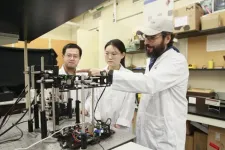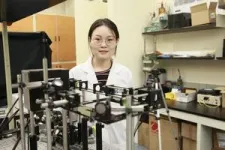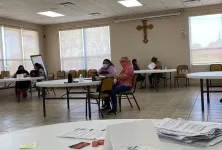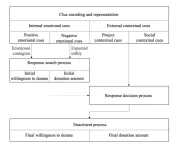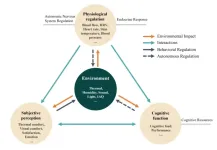(Press-News.org) Teams led by professors Jinyang Liang and Fiorenzo Vetrone from the Énergie Matériaux Télécommunications Research Centre at the Institut national de la recherche scientifique (INRS) have developed a new system for imaging nanoparticles. It consists of a high-precision, short-wave infrared imaging technique capable of capturing the photoluminescence lifetimes of rare-earth doped nanoparticles in the micro- to millisecond range.
This groundbreaking discovery, which was published in the journal Advanced Science, paves the way for promising applications, particularly in the biomedical and information security fields.
Rare-earth elements are strategic metals that possess unique light-emitting properties that make them very attractive research tools in cutting-edge science. What’s more, the photoluminescence lifetime of nanoparticles doped with these ions has the advantage of being minimally affected by external conditions. As a result, measuring it through imaging provides data from which accurate and highly reliable information can be derived.
Although this field is seeing remarkable progress, existing optical systems for this type of measurement were less than ideal.
“Until now, existing optical systems have offered limited possibilities due to inefficient photon detection, limited imaging speed, and low sensitivity,” explains Professor Jinyang Liang, a specialist in ultrafast imaging and biophotonics.
To date, the most common technique for measuring the photoluminescence lifetime of rare-earth doped nanoparticles has involved counting time-correlated single photons.
“This method requires a large number of repeated excitations at the same location because the detector can only process a limited number of photons for each excitation,” says the study’s first author Miao Liu, a Ph.D. student in energy and materials science supervised by Profs. Liang and Vetrone.
However, the long photoluminescence lifetimes of rare-earth doped nanoparticles in the infrared spectrum, from hundreds of microseconds to several milliseconds, restrict the excitation’s repetition rate. As a result, the pixel dwelling time needed to build the photoluminescence intensity decay curve is much longer.
Pushing the limits
To overcome this challenge, Liang and Vetrone’s teams have combined streak optics with a high-sensitivity camera. The resulting device is called SWIR-PLIMASC (SWIR for short-wave infrared and PLIMASC for photoluminescence lifetime imaging microscopy using an all-optical streak camera). It vastly improves mapping of the optical properties of short-wave infrared photoluminescence lifetimes. It is the first high-sensitivity, high-speed SWIR imaging system in the optics field.
“It has several advantages,” says Miao Liu. “For instance, it responds to a wide spectral range, from 900 nm to 1700 nm, allowing photoluminescence to be detected at different wavelengths and/or spectral bands.”
The Ph.D. student adds that with the help of this device, photoluminescence lifetimes in the infrared spectrum, from microseconds to milliseconds, can be directly captured in one snapshot with a 1D imaging speed that can be tuned from 10.3 kHz to 138.9 kHz.
Finally, the operation that allocates the temporal information of photoluminescence to different spatial positions ensures that the entire process of 1D photoluminescence intensity decay can be recorded in a single snapshot, without repeated excitation. “You save time, but still get high sensitivity,” sums up Miao Liu.
Biomedical and security applications
The work carried out as part of this research will have a very tangible impact. In the biomedical field, the advances made possible by SWIR-PLIMASC could be used to fight cancer, believes Professor Fiorenzo Vetrone, whose expertise lies in nanomedicine.
“As our system applies to the temperature-based photoluminescence lifetime imaging of rare-earth ions, we believe that the data obtained could, for example, help to detect cancer cells even earlier and more accurately. The metabolism of those cells raises the temperature of the surrounding tissues,” says Professor Vetrone.
The innovative system can also be used to store information at enhanced security levels, more specifically to prevent documents and data from being falsified. Finally, in fundamental science, these unprecedented results will allow scientists to synthesize rare-earth nanoparticles with even more interesting optical properties.
About the paper
The paper was co-written by Miao Liu, Yingming Lai, Miguel Marquez, Fiorenzo Vetrone, and Jinyang Liang. Entitled Short-wave Infrared Photoluminescence Lifetime Mapping of Rare-Earth Doped Nanoparticles Using All-Optical Streak Imaging, it was published in the January 6, 2024, edition of Advanced Science. https://doi.org/10.1002/advs.202305284
This research was funded by the Natural Sciences and Engineering Research Council of Canada, the Canada Research Chairs Program, the Canada Foundation for Innovation, the Ministère de l’Économie et de l’Innovation du Québec, the Canadian Cancer Society, the Government of Canada’s New Frontiers in Research Fund, as well as the Fonds de Recherche du Québec – Nature et Technologies and the Fonds de Recherche du Québec – Santé.
END
A faster, more efficient imaging system for nanoparticles
A new technique developed at INRS pushes back some of the limits of the infrared imaging of rare-earth doped nanoparticles
2024-01-30
ELSE PRESS RELEASES FROM THIS DATE:
Lifetime of ‘biodegradable’ straws in the ocean is 8-20 months, study finds
2024-01-30
Plastic drinking straws that get into marine ecosystems make beaches unsightly and pose problems for turtles and seabirds. So, people increasingly favor alternatives marketed as biodegradable or compostable. But do marine microorganisms break apart those straws? Researchers conducted experiments with seawater and report in ACS Sustainable Chemistry & Engineering that some commercial bioplastic or paper straws might disintegrate within eight to 20 months in coastal ocean systems and switching to ...
Tomato juice’s antimicrobial properties can kill salmonella
2024-01-30
Washington, D.C.—Tomato juice can kill Salmonella Typhi and other bacteria that can harm people's digestive and urinary tract health, according to research published this week in Microbiology Spectrum, a journal of the American Society for Microbiology. Salmonella Typhi is a deadly human-specific pathogen that causes typhoid fever.
“Our main goal in this study was to find out if tomato and tomato juice can kill enteric pathogens, including Salmonella Typhi, and if so, what qualities they ...
Joint efforts to ensure the sustainability of our one and only Earth
2024-01-30
The 37th International Geological Congress (IGC 2024) in August 2024, Busan, Korea, will highlight a growing concern amid urgent threats posed by accelerated climate and environmental changes. This will prompt collaborative efforts towards ensuring the sustainability of our planet.
Abnormally high temperatures across the globe during the past year were expected to make 2023 the hottest year in Earth's history. This realization underscores the concept of climate change, which was once confined to academic desks but has since permeated into our daily existence.
Geologists now assert that the rapid climate and environmental changes necessitate ...
KIMM develops technology for detecting injection of medication to prevent medical accidents related to analgesic drug infusion pump in hospitals
2024-01-30
Excessive administration of analgesic drugs frequently results in medical accidents. To prevent the occurrence of these accidents, a drug infusion pump featuring a technology for safely detecting medication administration has been developed for the first time in the world.
The research team led by Senior Researcher Dong-kyu Lee of the Korea Institute of Machinery and Materials (President Seog-hyun Ryu, hereinafter referred to as KIMM), an institute under the jurisdiction of the Ministry of Science and ICT, has succeeded in developing the technology for customized sensor modules capable of measuring the extremely low flow rate of analgesic drug infusion pumps as well as the existence ...
Machine sentience and you: what happens when machine learning goes too far
2024-01-30
There’s always some truth in fiction, and now is about the time to get a step ahead of sci-fi dystopias and determine what the risk in machine sentience can be for humans.
Although people have long pondered the future of intelligent machinery, such questions have become all the more pressing with the rise of artificial intelligence (AI) and machine learningT. These machines resemble human interactions: they can help problem solve, create content, and even carry on conversations. For fans ...
Drexel researchers propose AI-guided system for robotic inspection of buildings, roads and bridges
2024-01-30
Our built environment is aging and failing faster than we can maintain it. Recent building collapses and structural failures of roads and bridges are indicators of a problem that’s likely to get worse, according to experts, because it’s just not possible to inspect every crack, creak and crumble to parse dangerous signs of failure from normal wear and tear. In hopes of playing catch-up, researchers in Drexel University’s College of Engineering are trying to give robotic assistants the tools to help inspectors with the job.
Augmenting visual ...
Residents of rural ‘glades’ take a ‘leap of faith’ to combat dementia
2024-01-30
The prevalence of Alzheimer’s disease and related dementias (ADRD) is disproportionately high among rural, racially/ethnically diverse older residents. In fact, they face up to an 80 percent greater risk of cognitive impairment in older age, and 2.5 times potentially preventable ADRD-related hospitalizations compared to urban dwellers. It is estimated that early and accurate diagnosis in the mild cognitive impairment stage could save up to $7 trillion in patients’ health and long-term care costs by 2050.
To address these health disparities in rural underserved populations, researchers from Florida ...
Emotions drive donation behavior in disease relief projects on a fundraising platform
2024-01-30
The digital age has profoundly changed how we communicate as humans. Today, we can regularly interact with people we are unrelated to and unacquainted with in real time across the world. Because of this, individuals can now engage in prosocial behaviors, including cooperating, sympathizing, helping and donating, with complete strangers, but the motivating factors behind these behaviors are poorly understood. Analysis of data generated from a fundraising website suggests that positive emotions elicit higher total donation amounts while negative emotions result in higher individual donation amounts.
Fundraising ...
Comfort isn’t only a feeling, it’s a study
2024-01-30
A lot of factors go into an individual’s comfort, and it’s more than just how one feels about the temperature
The thermal environment refers to the physical surroundings as it pertains to the heat exchange of an individual and its environment. Naturally, the thermal environment also relates to comfort, or more specifically, thermal comfort. This type of comfort is an important metric to measure an individual’s feelings as it relates to their environment and can be directly associated with health, efficiency, comfort, and energy consumption. ...
After 7 years, alcohol control program still reduces child abuse
2024-01-30
COLUMBUS, Ohio – A neighborhood alcohol control project in Sacramento that reduced cases of child abuse and neglect soon after implementation still had a positive impact seven years later, a new study found.
Results showed that, in one of the neighborhoods where the program was put into place, total entries into foster care were reduced by 11.8% and alcohol-related foster care entries were reduced by 11.2% a full seven years after implementation.
These new results were not as strong as those found right after the project was implemented, and there are other caveats to the success of the program. But the results are still very encouraging, said Bridget Freisthler, ...
LAST 30 PRESS RELEASES:
Flaring black hole whips up ultra-fast winds
Study explores the link between newspaper preference and attitudes towards autism
Artificial turf in the Nordic climate – a question of sustainability
The hidden toll of substance use disorder: annual cost of lost productivity to US economy nearly $93 billion
Among psychologists, AI use is up, but so are concerns
Recycling a pollutant to make ammonia production greener
Common institutional ownership linked to less aggressive business strategies in Chinese firms
Energy and regional factors drive carbon price volatility in China’s emissions trading markets
Researchers from NUS Medicine and the Institute of Mental Health detect early brain changes linked to future psychosis development
Cryopreserved vs liquid-stored platelets for the treatment of surgical bleeding
Cost-effectiveness of cryopreserved vs liquid-stored platelets for managing surgical bleeding
Adaptive Kalman filter boosts BDS-3 navigation accuracy in challenging environments
Home-based monitoring could transform care for patients receiving T-cell redirecting therapies
Listening to the 'whispers' of electrons and crystals: A quantum discovery
Report on academic exchange (colloquium) with Mapua University
Sport in middle childhood can breed respect for authority in adolescence
From novel therapies to first-in-human trials, City of Hope advances blood cancer care at the American Society of Hematology (ASH) annual conference
Research aims to strengthen the security of in-person voting machines
New study exposes hidden Alzheimer’s 'hot spots' in rural Maryland and what they reveal about America’s growing healthcare divide
ASH 2025: Study connects Agent Orange exposure to earlier and more severe cases of myelodysplastic syndrome
ASH 2025: New data highlights promise of pivekimab sunirine in two aggressive blood cancers
IADR elects George Belibasakis as vice-president
Expanding the search for quantum-ready 2D materials
White paper on leadership opportunities for AI to increase employee value released by University of Phoenix College of Doctoral Studies
ASH 2025: New combination approach aims to make CAR T more durable in lymphoma
‘Ready-made’ T-cell gene therapy tackles ‘incurable’ T-cell leukemia
How brain activity changes throughout the day
Australian scientists reveal new genetic risk for severe macular degeneration
GLP-1 receptor agonists likely have little or no effect on obesity-related cancer risk
Precision immunotherapy to improve sepsis outcomes
[Press-News.org] A faster, more efficient imaging system for nanoparticlesA new technique developed at INRS pushes back some of the limits of the infrared imaging of rare-earth doped nanoparticles
